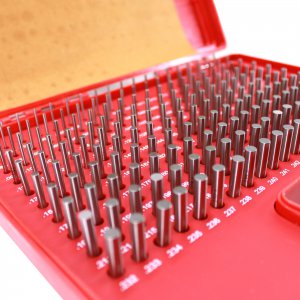So it appears you can do very well with this type of gauging. However, it is a certain amount of trouble to get under a tenth. With experience, it will probably become easier. After I measure a bunch of these pins, I'll have a better estimate of how much under nominal they are. I suppose the smart thing to do would be to build a library of the pins I've measured and prefer those over other unknown pins. At this point, I'm not sure if that juice is worth the squeeze. This is already a quite niche topic and I'm not sure how frequently I'll need +/- 0.000,01 gages.
The uncertainty in a pin tuple obvisouly depends on un-bent, non-tapered, non-lobed geometry of the individual pins. I imagine these pins come from centerless-ground stock that is lapped in fairly long pieces, then hacked into 2" pieces. If that is the process, it would reduce the obvious errors mentioned above. The method follows Abe's Law. A major disadvantage is that you can't easily verify the gage diameter so you're depending on calculations. Some pros, some cons. Depends on the metrology situation, just like all measurement methods.
Also, my attempts to roll the pins around the bore was not successful with a -0.00,1" gage. It was easy to take the small pin out, re-orient the remaining pins, and re-insert.


